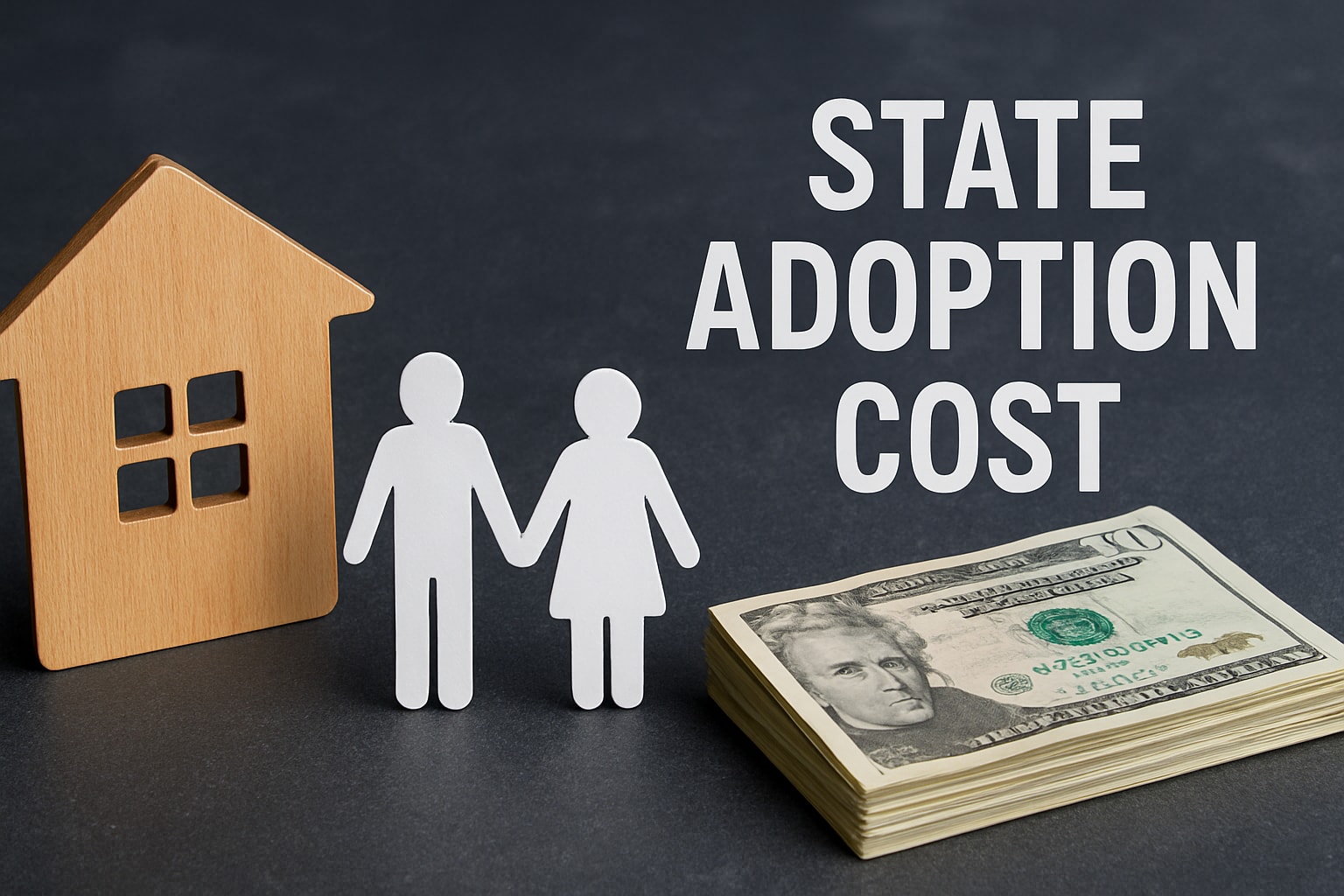
State Adoption Cost Guide: What Families Need to Know (2025)
Starting the adoption journey can feel like stepping into a maze, especially when the true state adoption cost is unclear. Many families find themselves overwhelmed by unexpected fees and confusing regulations. This guide is designed to bring clarity and confidence to your path.
You will discover a detailed breakdown of costs by state, insights into the different types of adoption, and practical tips for managing expenses. With expert advice and up-to-date information for 2025, you will be equipped to make smart, informed decisions. Take the first step toward your adoption goals with clarity and confidence.
Understanding Adoption Costs: Types and Key Factors
Navigating the world of adoption can feel like a maze, especially when it comes to untangling the details of state adoption cost. Knowing what to expect can help families plan wisely and avoid unpleasant surprises. This section breaks down the most common types of adoption, the major expenses you might face, and why costs can be so different depending on where you live.

Types of Adoption and Their Typical Costs
There are several primary paths to adoption in the United States, and each carries its own typical state adoption cost. The four main types are:
- Domestic Infant Adoption: This is usually coordinated through a private agency or attorney. Costs typically range from $20,000 to $50,000, depending on the service provider and state. For example, the average state adoption cost for a domestic infant in California is about $40,000, while Indiana averages closer to $30,000.
- Foster Care Adoption: Often the most affordable option, with a typical state adoption cost between $0 and $3,000. States frequently cover many fees, making this an accessible route for many families.
- International Adoption: Adopting a child from another country can cost between $25,000 and $60,000. This includes travel, immigration, and foreign agency fees.
- Step-Parent Adoption: Usually the least expensive, with costs mainly for court and legal fees.
Here’s a quick comparison:
| Adoption Type | Average State Adoption Cost | Notable Expenses |
|---|---|---|
| Foster Care | $0–$3,000 | Legal, home study |
| Domestic Infant | $20,000–$50,000 | Agency, legal, birth mother |
| International | $25,000–$60,000 | Travel, legal, foreign agency |
| Step-Parent | $1,000–$3,000 | Legal, court |
Understanding these differences is the first step to estimating your own state adoption cost and choosing the right path for your family.
Major Cost Components and Influencing Factors
When calculating state adoption cost, it’s important to look beyond the surface. Several major components contribute to the overall price tag:
- Home Study Fees: Required to assess your family’s readiness, ranging from $1,000 to $3,000.
- Legal Expenses: Attorney fees, court costs, and documentation can add up quickly.
- Agency or Program Fees: These often make up the bulk of the state adoption cost, especially for private and international adoptions.
- Birth Mother Expenses: Some states allow adoptive parents to cover medical, legal, and living expenses for birth parents, which can significantly increase the total cost.
- Travel Costs: Especially relevant in international or out-of-state adoptions.
State regulations have a big impact. For example, some states cap what you can pay in birth parent expenses, while others have fewer restrictions. Private adoptions often cost more than agency adoptions, but may offer flexibility. Don’t forget hidden costs like post-placement visits, counseling, or finalization fees, which can catch families off guard.
For a deeper dive into financial considerations, explore this Adoption Financial Resources guide, which covers grants, tax credits, and more.
State-by-State Variations in Adoption Cost
Why does state adoption cost differ so much across the country? Several factors come into play:
- Cost of Living: States like New York and California tend to have higher agency fees, while places like Texas or Indiana are usually more affordable.
- Legal Requirements: Some states require more extensive legal steps, increasing overall costs.
- Agency Pricing: Each agency sets its own rates, and these can vary widely by state.
For example, adopting a child in New York may cost significantly more than in Texas, even for the same type of adoption. In 2025, some states are seeing moderate cost increases due to inflation and new regulatory requirements, while others have introduced measures to cap fees and improve transparency.
Understanding these regional trends will help you build a realistic budget and avoid sticker shock. No matter where you start, being informed about your state adoption cost is the key to making smart, empowered decisions.
Step-by-Step Guide to Calculating Your State Adoption Costs
Calculating your state adoption cost can feel overwhelming, but breaking it down into clear steps can make the process manageable and empowering. Follow this guide to take control of your financial planning and make informed choices for your family.

Step 1: Identify Your Adoption Type and State Requirements
The first step in calculating your state adoption cost is to decide which type of adoption you want to pursue and understand your state’s unique requirements. Each state has its own rules regarding eligibility, home study procedures, and allowable expenses.
For example, California may require more extensive background checks and longer home study processes than Indiana. Review your state’s Department of Children and Families website for the latest regulations. This groundwork ensures you’re considering all costs that might be specific to your location and adoption type.
Step 2: Itemize Expected Expenses
Once you know your adoption type and state rules, start itemizing the expected expenses that will make up your state adoption cost. Typical costs include:
- Home study fees
- Agency or program fees
- Legal expenses
- Travel and lodging
- Background checks
- Post-placement supervision
Using a spreadsheet or adoption budget template can help you stay organized. Many families find it helpful to consult Financial Resources for Adoptive Families for guidance on grants, loans, and other ways to offset costs.
Step 3: Account for Variable and Hidden Costs
Don’t let hidden or variable costs catch you off guard when calculating your state adoption cost. Some expenses, like birth mother medical bills or legal finalization fees, may not be obvious at first.
Watch for:
- Medical expenses (if permitted by state law)
- Birth parent counseling or support
- Unexpected travel for court dates
- Post-placement visits
Talk to other adoptive families in your state to learn about surprise fees they encountered, and always ask agencies about potential hidden charges.
Step 4: Compare Agency, Attorney, and Independent Adoption Fees
Different adoption paths can significantly impact your state adoption cost. Agency adoptions often have higher fees due to bundled services, while attorney-only or independent adoptions may offer savings but require more legwork.
| Adoption Path | Typical Fee Range |
|---|---|
| Agency | $20,000–$40,000 |
| Attorney-Only | $8,000–$15,000 |
| Independent | $10,000–$25,000 |
Check if your state has fee caps or consumer protections. Request detailed quotes in writing and compare what is included in each provider’s fee structure before making a decision.
Step 5: Plan for Post-Adoption Expenses
Your state adoption cost does not end once your child is placed with you. Post-adoption expenses are often required for finalization and ongoing support.
These can include:
- Post-placement supervision visits
- Counseling or support services
- Finalization court fees
Some states may mandate several post-placement visits, each with its own cost. Factor these into your budget early to avoid last-minute financial strain.
Step 6: Request Quotes and Written Estimates
To get the most accurate picture of your state adoption cost, request itemized quotes and written estimates from every agency or attorney you consider. Transparent pricing protects you from surprises and allows for effective comparison.
Be alert for red flags such as vague pricing, reluctance to provide details, or pressure to sign quickly. A reputable provider will explain all fees, answer your questions, and provide clear documentation. Take your time reviewing all estimates before making a commitment.
Financial Assistance and Resources for Adoptive Families
Navigating the financial side of adoption can seem daunting, but a wide range of resources are available to help offset your state adoption cost. From tax credits to grants and community support, understanding your options can make adoption more affordable and accessible.

Federal and State Adoption Tax Credits
One of the most significant ways to reduce your state adoption cost is by claiming the federal adoption tax credit. For 2025, families may receive up to $15,950 per child, though this credit is non-refundable. Eligibility typically includes most domestic and international adoptions, but not step-parent adoptions.
Some states offer their own adoption tax credits, adding another layer of potential savings. These vary in amount and eligibility, so it is critical to check your state’s Department of Revenue for current details. To maximize your benefit, carefully track all qualified expenses and consult a tax professional for guidance. For a detailed breakdown of how to claim these credits and what expenses qualify, review this comprehensive Adoption Tax Credit Details guide.
Grants, Loans, and Employer Benefits
Many organizations help families manage their state adoption cost by providing grants and low-interest loans. Notable national grants include the Gift of Adoption Fund and HelpUsAdopt, both of which offer financial assistance to eligible families. These grants do not usually require repayment.
Low-interest adoption loans can also provide vital support, though families should weigh the pros and cons before borrowing. Some loans come with flexible repayment terms, but interest does add to your total cost over time.
Employer adoption benefits are another valuable resource. Many companies now offer reimbursement programs, with average coverage ranging from $5,000 to $25,000 per adoption. Check with your HR department early in the process to understand what is available and how to apply.
State Subsidies and Foster Care Adoption Assistance
If you are considering foster care or adopting a child with special needs, state subsidies can significantly lower your state adoption cost. These subsidies may include monthly payments, Medicaid coverage, and tuition waivers for college. For example, Indiana offers adoption subsidies based on the child’s needs and family income.
Eligibility for these programs often depends on the child’s status and the type of adoption. The application process usually involves working with your local child welfare agency, submitting documentation, and completing required training. These resources can make adoption more manageable for families who qualify.
Fundraising and Community Support
Many families turn to fundraising to help cover their state adoption cost, using creative and community-based approaches. Crowdfunding platforms like GoFundMe and AdoptTogether allow you to share your story and receive donations from friends, family, and even strangers.
Hosting local events, such as bake sales or silent auctions, can also build support and raise needed funds. Churches and community groups often provide grants or organize fundraisers to help families. However, always consider the legal and ethical aspects of fundraising for adoption. Some states have specific rules about how funds can be solicited and used, so research your local guidelines to ensure compliance. Remember, transparency and honesty are key to maintaining trust with your supporters.
How State Laws and Policies Affect Adoption Costs
Navigating the state adoption cost landscape can be challenging, especially when every state sets its own rules and regulations. Understanding how these laws and policies shape your expenses is crucial. By breaking down key factors, you can make decisions that protect your budget and your family’s future.

Legal Requirements Impacting Expenses
Every state determines its own adoption laws, which directly impact your state adoption cost. Key requirements include home study regulations, mandatory legal representation, and court fees. For example, some states require more extensive background checks or multiple post-placement visits, driving up costs.
State limits on birth parent expenses also play a major role. For instance, Alabama restricts these payments more tightly than Florida, which allows a wider range of reimbursable expenses. Here’s a quick comparison:
| State | Birth Parent Expense Limits | Court Fees | Home Study Costs |
|---|---|---|---|
| Alabama | Strict, limited | Moderate | $1,000–$2,000 |
| Florida | Broad, more permissible | High | $1,500–$3,000 |
If you’re adopting across state lines, the Interstate Compact on the Placement of Children (ICPC) introduces additional legal steps and costs. These requirements can add both time and money to your journey, making it essential to research your state adoption cost early in the process.
Agency Licensing and Fee Transparency
State oversight of adoption agencies is designed to protect families from unethical practices and unpredictable state adoption cost changes. Most states require agencies to be licensed, undergo regular audits, and clearly disclose their fee structures.
Indiana, for example, mandates that all adoption agencies meet strict licensing requirements and offer transparent itemized cost breakdowns. When evaluating agencies, always verify their credentials through your state’s licensing board. Look for clear financial disclosures and ask for written estimates upfront.
It’s also smart to understand how your state adoption cost might fluctuate between private and agency adoptions. Agencies typically have standardized fees, while private adoptions can be less predictable. To help manage expenses, explore Adoption Financial Assistance Programs that may be available in your state, but always confirm eligibility based on your local laws.
Recent Policy Changes and 2025 Updates
Adoption laws are constantly evolving, and 2025 brings new trends that could affect your state adoption cost. Many states are enacting stricter transparency requirements for agencies and attorneys. These laws require agencies to provide detailed fee schedules and prohibit hidden charges.
Some states have also introduced new caps on birth parent expenses, aiming to create a fairer process for adoptive families. Legislative updates may include streamlined court procedures, reducing administrative costs and delays. Staying informed about these changes can help you anticipate shifts in your state adoption cost and avoid unexpected expenses.
Always check your state’s latest adoption legislation before beginning the process. By understanding the legal landscape, you can prepare for changes and protect your investment.
Tips for Managing and Reducing Adoption Costs
Navigating the financial side of adoption can feel daunting. But with the right strategies, you can take control of your state adoption cost and make your family’s dream more affordable. Let’s break down the most effective tips to keep your costs in check.
Research and Compare Providers Thoroughly
Start by comparing agencies, attorneys, and independent providers in your state. Each provider can have a different approach to state adoption cost, so shopping around is essential.
Ask for detailed, written estimates from several sources. Look for transparency in agency fee schedules and ask about any possible extra charges.
- Request a breakdown of all fees
- Check agency credentials and reviews
- Watch for red flags like vague pricing or pressure to commit
Taking these steps helps you avoid surprises and ensures your state adoption cost reflects only necessary expenses.
Maximize Financial Support and Benefits
Explore every avenue for financial assistance to offset your state adoption cost. Apply early for adoption grants and use the federal adoption tax credit, which can provide significant savings.
Many employers offer adoption benefits, so ask your HR department about available programs. Some organizations even provide up to $25,000 in reimbursement.
- Research national grant programs like Gift of Adoption Fund
- Check eligibility for state and federal tax credits
- Investigate low-interest adoption loans
By layering these resources, you can reduce out-of-pocket expenses and lower your total state adoption cost.
Consider Less Expensive Adoption Paths
If your budget is tight, consider adoption paths with lower costs. Foster care adoption is often the most affordable, with many states offering subsidies that can significantly reduce your state adoption cost.
Step-parent and relative adoptions also tend to be more affordable and have faster timelines.
| Adoption Path | Typical Cost Range | Subsidies Available |
|---|---|---|
| Foster Care | $0–$3,000 | Yes |
| Domestic Infant | $20,000–$50,000 | Sometimes |
| International | $25,000–$60,000 | Rarely |
| Step-Parent/Relative | $1,000–$3,000 | No |
Review all options to see which aligns best with your goals and lowers your state adoption cost.
Negotiate Fees and Payment Plans
Don’t be afraid to negotiate with agencies or attorneys about your state adoption cost. Many providers are open to flexible payment plans or reduced fees, especially if you demonstrate financial need.
- Ask for fee waivers or sliding scale costs
- Request a payment plan that matches your budget
- Get all agreements in writing to avoid misunderstandings
Families have successfully negotiated thousands off their state adoption cost by simply asking the right questions and being persistent.
Plan for Long-Term Financial Impacts
Adoption costs do not end at placement. Factor in long-term expenses related to medical care, counseling, and education.
Create an adoption savings plan early to prepare for these ongoing needs. Setting aside funds each month can help you manage your future state adoption cost without stress.
- Budget for post-adoption services
- Explore community resources for ongoing support
- Review your financial plan annually
Being proactive ensures your family is ready for the full spectrum of state adoption cost, both now and in the years ahead.
Common Pitfalls and How to Avoid Unexpected Adoption Costs
Navigating the state adoption cost landscape can feel like a maze, especially when unexpected expenses pop up. Many families are caught off guard by hidden fees, unclear provider practices, and shifting legal requirements. Awareness is your best defense. Below, we break down the most common pitfalls and show you how to avoid them so your adoption journey stays on track.
Overlooking Hidden or Post-Placement Expenses
Even the most detailed state adoption cost estimate can miss hidden fees. Many families budget for agency and legal costs but forget about travel, birth parent support, or required counseling sessions. For example, post-placement supervision visits may cost several hundred dollars each and are often required by law.
Here are common hidden expenses to watch for:
- Travel and lodging for court appearances or birth parent meetings
- Birth parent living or medical expenses (where permitted by state law)
- Counseling and support services before and after placement
- Finalization fees and additional legal filings
A real family in Texas reported spending an extra $2,000 on unexpected travel for court hearings. To avoid surprises, use a state adoption cost calculator and talk to your provider about all possible fees upfront.
Falling for Unethical or Unlicensed Providers
Choosing the right provider is crucial to managing your state adoption cost. Some families fall prey to agencies or attorneys who promise low fees but hide details or lack proper licensing. Watch out for these red flags:
- Vague or changing pricing with no written estimates
- Pressure to sign contracts quickly
- Lack of credentials or state licensing
- Poor communication or refusal to answer questions
Always verify an agency’s license and check online reviews. Ask for a complete fee schedule in writing. If something feels off, trust your instincts and keep searching for a reputable provider.
Misunderstanding State-Specific Legal Requirements
Each state has unique rules that directly impact your state adoption cost. For instance, allowable birth parent expenses differ widely between states like Alabama and Florida. Some states require extra background checks, while others have stricter home study guidelines.
Key areas where requirements differ:
- Documentation and paperwork
- Mandatory waiting periods
- Court fees and legal representation
- Limits on reimbursable expenses
Before starting, research your state’s adoption laws thoroughly. Contact your local child welfare agency or consult a family law attorney with adoption experience.
Underestimating Time and Administrative Costs
Delays in the adoption process can drive up your state adoption cost. Missed paperwork, slow background checks, or rescheduled court hearings all add up. Administrative fees, updated home studies, and extra travel can surprise even well-prepared families.
Tips for avoiding costly delays:
- Stay organized with a checklist of required documents
- Respond quickly to requests from your agency or lawyer
- Schedule appointments and court hearings as early as possible
- Budget a cushion for unexpected administrative expenses
By planning ahead and staying proactive, you can minimize extra costs and keep your adoption journey on budget.
Now that you’ve got a clearer picture of adoption costs and what to expect in your state, it’s totally normal to feel a bit overwhelmed by all the steps and decisions ahead. The good news is, you don’t have to figure it out alone. We’re here to support you with counseling, legal guidance, and practical resources—whether you’re an expectant mom or a family navigating home studies and background checks. If you’re looking for even more insight and reassurance, check out our Free Expectant Mother Guide to help you make confident, informed choices every step of the way.

